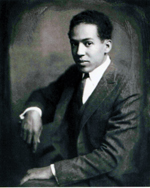University Chorus will celebrate the cultural legacy of Harlem Saturday

Langston Hughes
"Songs and Poems of Harlem" performed by the Brandeis University Chorus
Saturday, April 17 at 7 p.m.
Slosberg Music Center
"Looking for Langston"
Through May 23
Rose Art Museum
“A renaissance of American Negro literature is due; the material about us in the strange, heart-rending race tangle is rich beyond dream and only we can tell the tale and sing the song from the heart."
-- W.E.B. Du Bois (1920)
On Saturday, April 17 at 7 p.m. in Slosberg Music Center, the Brandeis University Chorus will unite spoken word and music in a uniquely interdisciplinary concert, "Songs and Poems of Harlem." The performance will celebrate both the music and literature associated with New York City in the 1920s and '30s, with a specific focus on the culture of the Harlem Renaissance. The evening will feature poetry by Langston Hughes, Claude McKay, Countee Cullen, and James Weldon Johnson; and music ranging from African-American spirituals to popular standards such as Duke Ellington’s “It Don’t Mean a Thing (If It Ain’t Got That Swing)” and “Summertime” from George Gershwin’s opera "Porgy and Bess." The Brandeis University Chorus will perform under the direction of James Olesen.
What is now known as the Harlem Renaissance was developed by African-American writers who believed that literature and the arts would help advance social acceptance and civil rights and establish a new African-American identity. In his 1994 book "Black Music in the Harlem Renaissance," Samuel A. Floyd Jr. wrote: "The Harlem Renaissance has been treated primarily as a literary movement. In fact, the stance of the black leadership during the period suggest the primacy of music to Renaissance philosophy and practice ... Renaissance leaders hoped the 'New Negro' would attend concerts and operas and would be economically and socially prepared to enter an ideally integrated American society.”
Many of the writers of the period, including Langston Hughes, incorporated the rhythms of blues and jazz into their poetry. In his essay “Mountain,” Hughes wrote: "Let the blare of Negro jazz bands and bellowing voice of Bessie Smith singing Blues penetrate the closed ears…until they listen and perhaps understand…We build our temples for tomorrow, strong as we know how, and we stand on top of the mountain, free within ourselves."
At Brandeis’ Rose Art Museum, viewers can discover more about Langston Hughes and the Harlem Renaissance with the 1989 award-winning film "Looking for Langston" by Isaac Julien. This controversial work combines authentic archival newsreel footage of Harlem in the 1920s with scripted scenes to produce a non-linear impressionistic story line celebrating African-American gay identity. Julien's work has been acclaimed for breaking barriers between artistic disciplines including film, dance, photography, and music, and uniting them to construct a powerfully visual narrative. The 42-minute film is intended for adults and runs continuously in the Rose’s Mildred Lee Gallery.
"Songs and Poems of Harlem"
Saturday, April 17 at 7 p.m.
Slosberg Music Center
Tickets are $10 general public/$5 students and seniors. They can be purchased online at Brandeis Tickets or by calling 781-736-3400.
"Looking for Langston"
Through May 23
Rose Art Museum
Free and open to the public





